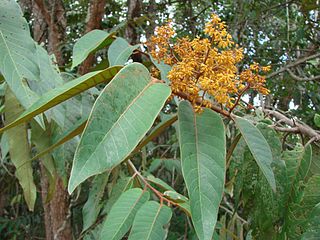
Ayahuasca is a South American psychoactive brew used as a traditional spiritual medicine in ceremonies among the indigenous peoples of the Amazon basin. It is an entheogenic brew commonly made out of the Banisteriopsis caapi vine, and the Psychotria viridis shrub or a substitute, and possibly other ingredients; although, a chemically similar preparation, sometimes called "pharmahuasca", can be prepared using N,N-Dimethyltryptamine (DMT) and a pharmaceutical monoamine oxidase inhibitor (MAOI) such as isocarboxazid. B. caapi contains several alkaloids that act as MAOIs, which are required for DMT to be orally active. The other required ingredient is a plant that contains the primary psychoactive, DMT. This is usually the shrub P. viridis, but Diplopterys cabrerana may be used as a substitute. Other plant ingredients often or occasionally used in the production of ayahuasca include Justicia pectoralis, one of the Brugmansia or Datura species, and mapacho.

N,N-Dimethyltryptamine is a chemical substance that occurs in many plants and animals and which is both a derivative and a structural analog of tryptamine. It is used as a recreational psychedelic drug and prepared by various cultures for ritual purposes as an entheogen.

5-MeO-DMT (5-methoxy-N,N-dimethyltryptamine) or O-methyl-bufotenin is a psychedelic of the tryptamine class. It is found in a wide variety of plant species, and at least one toad species, the Sonoran Desert toad. Like its close relatives DMT and bufotenin (5-HO-DMT), it has been used as an entheogen in South America. Slang terms include Five-methoxy, The power, and Toad venom.

Anadenanthera peregrina, also known as yopo, jopo, cohoba, parica or calcium tree, is a perennial tree of the genus Anadenanthera native to the Caribbean and South America. It grows up to 20 m (66 ft) tall, and has a horny bark. Its flowers grow in small, pale yellow to white spherical clusters resembling Acacia inflorescences. It is an entheogen which has been used in healing ceremonies and rituals for thousands of years in northern South America and the Caribbean.

DET, also known under its chemical name N,N-diethyltryptamine and as T-9, is a psychedelic drug closely related to DMT and 4-HO-DET. However, despite its structural similarity to DMT, its activity is induced by an oral dose of around 50–100 mg, without the aid of MAO inhibitors, and the effects last for about 2–4 hours.

Psychotria viridis is a perennial, shrubby flowering plant in the coffee family Rubiaceae. It is a close relative of Psychotria carthagenensis of Ecuador. In the Quechua languages it is called chacruna or chacrona. In Quechua, chaqruy is a verb meaning "to mix".

Mimosa tenuiflora, syn. Mimosa hostilis, also known as jurema preta, calumbi (Brazil), tepezcohuite (México), carbonal, cabrera, jurema, black jurema, and binho de jurema, is a perennial tree or shrub native to the northeastern region of Brazil and found as far north as southern Mexico, and the following countries: El Salvador, Honduras, Panama, Colombia and Venezuela. It is most often found in lower altitudes, but it can be found as high as 1,000 m (3,300 ft).

Anadenanthera colubrina is a South American tree closely related to yopo, or Anadenanthera peregrina. It grows to 5–20 m (16–66 ft) tall and the trunk is very thorny. The leaves are mimosa-like, up to 30 cm (12 in) in length and they fold up at night. In Argentina, A. colubrina produces flowers from September to December and bean pods from September to July. In Brazil A. colubrina has been given "high priority" conservation status.

Diplopterys cabrerana is a vine native to the Amazon Basin, spanning the countries of Brazil, Colombia, Ecuador and Peru. In the Quechua languages it is called chaliponga or chagropanga; in parts of Ecuador it is known as chacruna—a name otherwise reserved for Psychotria viridis.

N-Methyltryptamine (NMT) is a member of the substituted tryptamine chemical class and a natural product which is biosynthesized in the human body from tryptamine by certain N-methyltransferase enzymes, such as indolethylamine N-methyltransferase. It is a common component in human urine. NMT is an alkaloid derived from L-tryptophan that has been found in the bark, shoots and leaves of several plant genera, including Virola, Acacia, Mimosa, and Desmanthus—often together with the related compounds N,N-dimethyltryptamine (DMT) and 5-methoxy-N,N-dimethyltryptamine (5-MeO-DMT).
Anadenanthera colubrina var. cebil is a mimosa-like timber tree native to Caatinga and Cerrado vegetation in Argentina, Bolivia, Brazil, Paraguay and Peru. It has also been introduced to Mauritius. It grows up to 25 m (82 ft) tall, with a trunk diameter of 60–90 cm (24–35 in). The tree's mimosa-like leaves range in length from about 7–20 cm (2.8–7.9 in). The flowers are cream-colored and arrive in the spring. The seed pods are fairly straight and contain about 8 to 15 seeds each. The seeds are flat, average each about 1.5 cm (0.59 in) in diameter and have an average mass of about 0.125 g (0.0044 oz) each. The tree's wood has a density of about 840 kg/m3 (1,420 lb/cu yd).

5,N,N-trimethyltryptamine is a tryptamine derivative that is a psychedelic drug. It was first made in 1958 by E. H. Young. In animal experiments it was found to be in between DMT and 5-MeO-DMT in potency which would suggest an active dosage for humans in the 20–60 mg range. Human psychoactivity for this compound has been claimed in reports on websites such as Erowid but has not been independently confirmed.

Acacia obtusifolia, commonly known as stiff-leaf wattle or blunt-leaf wattle, is a perennial tree in subfamily Mimosoideae of family Fabaceae.

5-Bromo-DMT (5-bromo-N,N-dimethyltryptamine) is a psychedelic brominated indole alkaloid found in the sponges Smenospongia aurea and Smenospongia echina, as well as in Verongula rigida alongside 5,6-Dibromo-DMT and seven other alkaloids. It is the 5-bromo derivative of DMT, a psychedelic found in many plants and animals.

5-MeS-DMT (5-methylthio-N,N-dimethyltryptamine) is a lesser-known psychedelic drug. It is the 5-methylthio analog of dimethyltryptamine (DMT). 5-MeS-DMT was first synthesized by Alexander Shulgin. In his book TiHKAL, the minimum dosage is listed as 15-30 mg. The duration listed as very short, just like DMT. 5-MeS-DMT produces similar effects to DMT, but weaker. Shulgin describes his feelings while on a low dose of this drug as "pointlessly stoned", although at a higher dose of 20 mg he says it is "quite intense" and suggests that a higher dose still might have full activity.

Virola sebifera is a species of tree in the family Myristicaceae, from North and South America.

Virola elongata is a species of tree in the family Myristicaceae. The tree is native to Panama, Guyana, Brazil, Bolivia, Colombia, Ecuador and Peru. It is also found in Suriname. Virola elongata is thin and 7.5–23 m (25–75 ft) tall, sometimes 30 m (98 ft) tall.















